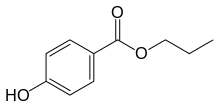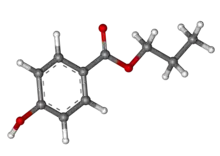Propylparaben
Propylparaben, the n-propyl ester of p-hydroxybenzoic acid, occurs as a natural substance found in many plants and some insects, although it is manufactured synthetically for use in cosmetics, pharmaceuticals, and foods.[1] It is a member of the class of parabens. It is a preservative typically found in many water-based cosmetics, such as creams, lotions, shampoos, and bath products.[2] As a food additive, it has the E number, which is E216.
 | |
 | |
| Names | |
|---|---|
| Preferred IUPAC name
Propyl 4-hydroxybenzoate | |
Other names
| |
| Identifiers | |
3D model (JSmol) |
|
| ChEBI | |
| ChEMBL | |
| ChemSpider | |
| ECHA InfoCard | 100.002.098 |
| EC Number |
|
| E number | E216 (preservatives) |
| KEGG | |
PubChem CID |
|
| UNII | |
CompTox Dashboard (EPA) |
|
| |
| |
| Properties | |
| C10H12O3 | |
| Molar mass | 180.203 g·mol−1 |
| Density | 1.0630 g/cm3 |
| Melting point | 96 to 99 °C (205 to 210 °F; 369 to 372 K) |
| Hazards | |
| NFPA 704 (fire diamond) | |
| Related compounds | |
Related compounds |
Paraben Butylparaben Ethylparaben Methylparaben |
Except where otherwise noted, data are given for materials in their standard state (at 25 °C [77 °F], 100 kPa).
Infobox references | |
Sodium propyl p-hydroxybenzoate, the sodium salt of propylparaben, a compound with formula Na(C3H7(C6H4COO)O), is also used similarly as a food additive and as an anti-fungal preservation agent. Its E number is E217.
In 2010, the European Union Scientific Committee on Consumer Safety stated that it considered the use of butylparaben and propylparaben as preservatives in finished cosmetic products as safe to the consumer, as long as the sum of their concentrations does not exceed 0.19%.[3]
Uses
Propylparaben has antifungal and antimicrobial properties and is typically used in a variety of water-based cosmetics and personal-care products.[4] It is also used as a food additive, and is designated with E number, E216. Propylparaben is commonly used as a preservative in packaged baked goods, particularly pastries and tortillas.[5] Propylparaben is also a Standardized Chemical Allergen and is used in allergenic testing.[6][7]
As of May 2023, New York began considering banning the use of propylparaben because studies in humans and animals indicate that it acts as an endocrine disrupter and affects male and female reproductive health.[1][5]
In September of 2023, California passed legislation outlawing the use of propylparaben in foods by 2027.[8] The new law bans the manufacture, sale and distribution of propylparaben and three other additives. This is the first law in the U.S. to ban it and will possibly have nationwide effects.[9]
References
- Oishi (2002). "Effects of propyl paraben on the male reproductive system". Food and Chemical Toxicology. 40 (12): 1807–13. doi:10.1016/s0278-6915(02)00204-1. PMID 12419695.
- PubChem. "Propylparaben". pubchem.ncbi.nlm.nih.gov. Retrieved 2021-12-01.
- Directorate-General for Consumer Safety, European Union (2011). "Scientific Committee on Consumer Safety Opinion on Parabens COLIPA n° P82" (PDF). Retrieved December 15, 2017.
- "propylparaben (CHEBI:32063)". www.ebi.ac.uk. Retrieved 2021-12-01.
- Dana G. Smith (April 13, 2023). "Two States Have Proposed Bans on Common Food Additives Linked to Health Concerns". New York Times. Retrieved May 23, 2023.
- "DailyMed - Browse Drug Classes". dailymed.nlm.nih.gov. Retrieved 2021-12-01.
- "Propylparaben". go.drugbank.com. Retrieved 2021-12-01.
- Chuck, Elizabeth (2023-09-12). "California Legislature passes first bill in U.S. to ban food additives, including red dye No. 3". www.nbcnews.com. Retrieved 2023-09-14.
- California isn’t banning Skittles, but four additives will be removed by Marlene Cimons, Washington Post, Oct. 11, 2023. The article notes that Red dye No. 3, bromated vegetable oil, potassium bromate and propyl paraben all have been linked to risk of cancer and hyperactivity in children.
